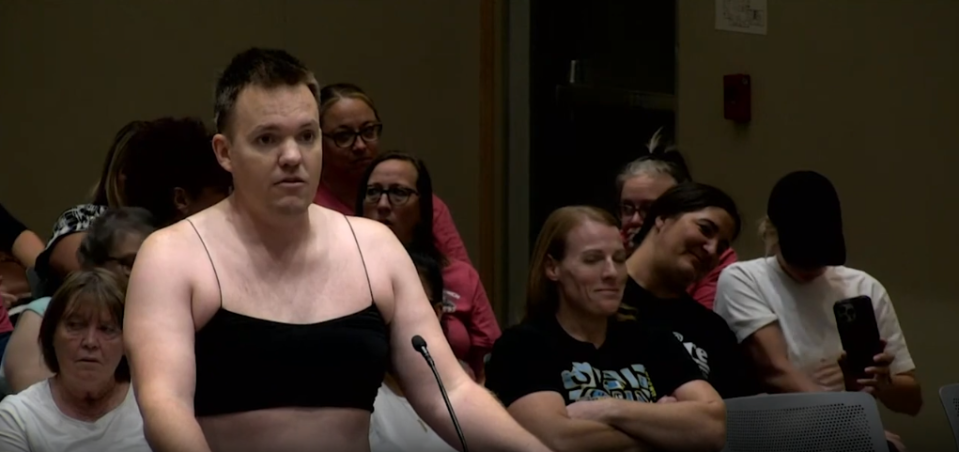Higley Unified's board has been arguing about midriffs. Here's the resolution
A monthslong, contentious debate over whether to change a decades-old student dress code in the East Valley's Higley Unified School District finally reached a resolution in September, with the governing board's approval of a new policy.
The crux of the debate has been whether students should be permitted to show midriffs. The policy the board ultimately decided on, approved during a Sept. 20 board meeting with a 3-2 vote, requires clothing to "cover all private body parts" and prohibits undergarments from being worn as clothing, though "undergarment waistbands and/or straps that are incidentally visible under clothing are permitted."
Unlike the district's former policy, it does not explicitly prohibit midriff exposure.
At the September meeting, in protest of the proposed dress code policy, one father — who told the board he has four children who attend school in the district — stripped down to a top that revealed his midriff.
"Because I have no other way to describe my concerns about this policy, I'll do an object lesson," Ira Latham told the board during public comment.
Debate over midriffs: Higley Unified School District board splits over whether students can show midriffs
"Under the proposed policy, this would be appropriate in a classroom," he said, before taking off his polo shirt to reveal a black, spaghetti strap crop top.
He said he wanted the board to limit "needless distractions" and help students prepare for the workforce. "I can't think of any place of work where I could walk in an interview and be taken serious in something like this," he said.
The district's former dress code policy was approved in 2001 and was due for review, according to district spokesperson Teresa Joseph. It included prohibiting student attire that "interferes with or disrupts the educational environment or educational objectives" or "immodestly exposes the chest, abdomen, midriff, genital area or buttocks."
In earlier meetings, board members clashed over whether students should be permitted to show midriffs.
During an August debate, board President Tiffany Shultz said that prohibiting exposure of midriffs and undergarments makes girls feel bad about their bodies by telling them they need to cover up "because of the way it might make someone else feel," and that crop tops are in style. Board member Amanda Wade pointed out that Arizona summers are hot and said that language prohibiting "midriffs, undergarments or undergarment areas" disproportionately impacts students who wear bras or bra straps.

On the other side of the debate, board members Anna Van Hoek and Michelle Anderson argued that a stricter dress code was necessary to teach self-respect and prepare students for the workforce. The fifth board member, Kristina Reese, declined to cast a deciding vote on the proposal before the board at that August meeting.
Reese ultimately decided to vote in support of the policy proposed at the September meeting. In a comment, she said the existing policy was ineffective. Even though the district policy being replaced prohibited midriffs, some students still revealed parts of their stomachs, she said.
"It wasn't offensive. ... I didn't see people looking at other people," she said.
Students have already been dressing this way, and it isn't 'over-revealing,'" Reese said.
In response to the suggestion that a stricter dress code is necessary to prepare students for the workforce, Reese said that schools are not businesses and students are not yet professionals.
"They're kids, and we need to teach them, but I don't think this dress code teaches them not to be a good person," she said. "I don't think the dress code teaches them not to have to adapt when you get a job."
If the board finds that the new policy doesn't work well, Reese said, they can revisit it.
Nearby East Valley districts have various requirements for clothing in school.
Mesa Public Schools' policy states that clothing must "cover the entire midriff, with material that covers the front, back and sides," according to its website.
In May, Gilbert Public Schools updated its dress code policy to remove a requirement that clothing must cover the entire midriff and changed language that said clothing "must cover a student's undergarments, chest, buttocks and torso" to "clothing must cover all private body parts and must not be see through."
Queen Creek Unified School District's policy prohibits the exposure of "undergarments, or undergarment areas," but does not have language that prohibits midriff exposure, according to the website of the Arizona School Risk Retention Trust, which creates model policies for school districts across the state.
Madeleine Parrish covers K-12 education. Reach her at mparrish@arizonarepublic.com and follow her on X, formerly known as Twitter: @maddieparrish61.
This article originally appeared on Arizona Republic: Higley Unified school board ends midriff debate with new dress code

